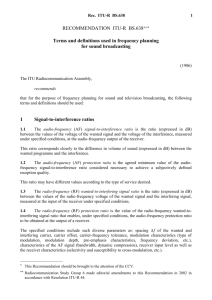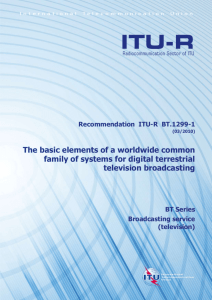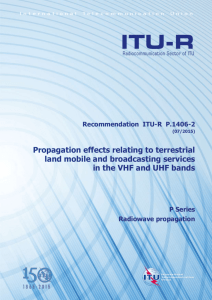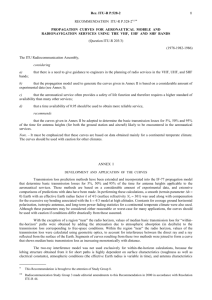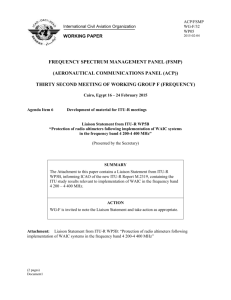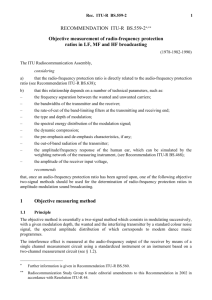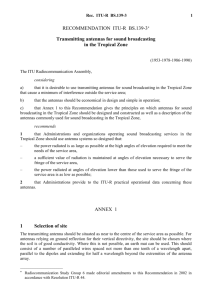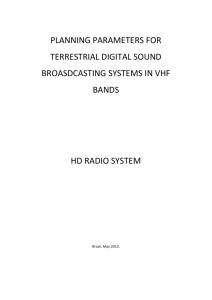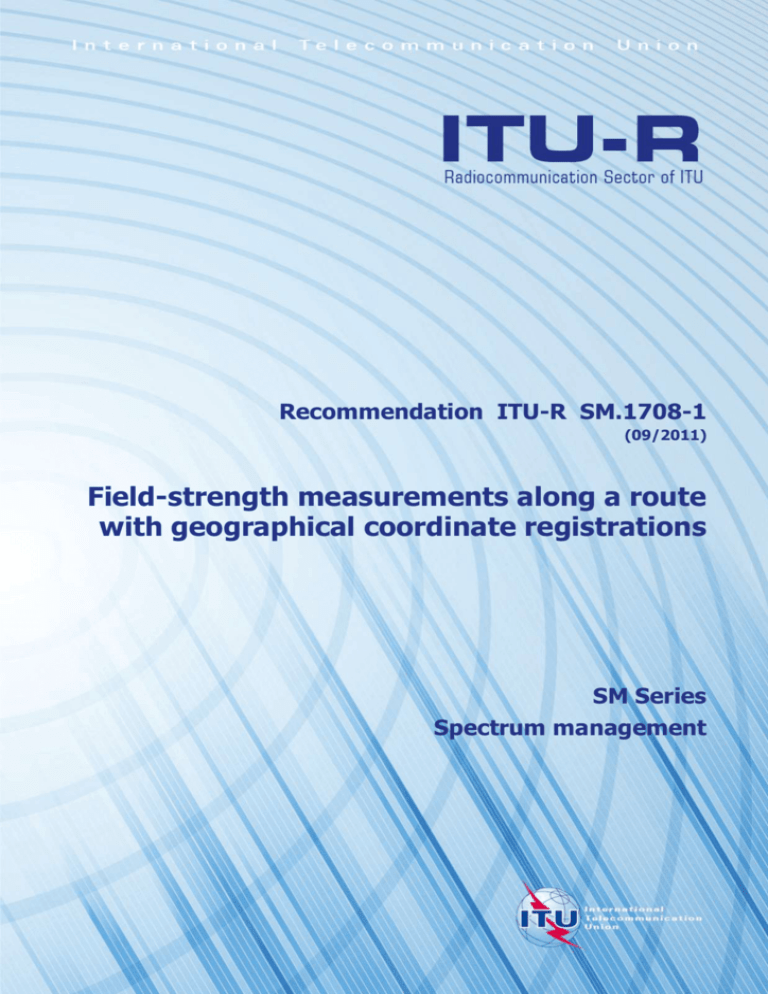
Recommendation ITU-R SM.1708-1
(09/2011)
Field-strength measurements along a route
with geographical coordinate registrations
SM Series
Spectrum management
ii
Rec. ITU-R SM.1708-1
Foreword
The role of the Radiocommunication Sector is to ensure the rational, equitable, efficient and economical use of the
radio-frequency spectrum by all radiocommunication services, including satellite services, and carry out studies without
limit of frequency range on the basis of which Recommendations are adopted.
The regulatory and policy functions of the Radiocommunication Sector are performed by World and Regional
Radiocommunication Conferences and Radiocommunication Assemblies supported by Study Groups.
Policy on Intellectual Property Right (IPR)
ITU-R policy on IPR is described in the Common Patent Policy for ITU-T/ITU-R/ISO/IEC referenced in Annex 1 of
Resolution ITU-R 1. Forms to be used for the submission of patent statements and licensing declarations by patent
holders are available from http://www.itu.int/ITU-R/go/patents/en where the Guidelines for Implementation of the
Common Patent Policy for ITU-T/ITU-R/ISO/IEC and the ITU-R patent information database can also be found.
Series of ITU-R Recommendations
(Also available online at http://www.itu.int/publ/R-REC/en)
Series
BO
BR
BS
BT
F
M
P
RA
RS
S
SA
SF
SM
SNG
TF
V
Title
Satellite delivery
Recording for production, archival and play-out; film for television
Broadcasting service (sound)
Broadcasting service (television)
Fixed service
Mobile, radiodetermination, amateur and related satellite services
Radiowave propagation
Radio astronomy
Remote sensing systems
Fixed-satellite service
Space applications and meteorology
Frequency sharing and coordination between fixed-satellite and fixed service systems
Spectrum management
Satellite news gathering
Time signals and frequency standards emissions
Vocabulary and related subjects
Note: This ITU-R Recommendation was approved in English under the procedure detailed in Resolution ITU-R 1.
Electronic Publication
Geneva, 2011
ITU 2011
All rights reserved. No part of this publication may be reproduced, by any means whatsoever, without written permission of ITU.
Rec. ITU-R SM.1708-1
1
RECOMMENDATION ITU-R SM.1708-1
Field-strength measurements along a route with geographical
coordinate registrations
(Questions ITU-R 214/1 and ITU-R 215/1)
(2005-2011)
The ITU Radiocommunication Assembly,
considering
a)
that the number of mobile networks using different modulation types and accesses
techniques is increasing;
b)
that in order to ensure efficient use of the spectrum administrations have a need to know the
radio coverage of networks;
c)
that field-strength prediction needs support by practical measurements performed by
monitoring;
d)
that mobile field-strength measurements are sometimes the only solution for determining
the radio coverage of a large area;
e)
that regulators may need to check the coverage deployment of a network according to
licence;
f)
different methods of mobile field-strength measurement are used by administrations,
recognizing
a)
that common measurement procedures are necessary in order to achieve mutual acceptance
of measurement results by the parties concerned,
recommends
1
that the method described in Annex 1 should be used for field-strength measurements of
vertically polarized signals along a route.
Annex 1
1
General
Influenced by the local receiving conditions, the real values of the field strength can significantly
differ from their predicted values, therefore they must be checked by measurements for establishing
the radio field-strength coverage of a large area.
Registration of test results must be recorded along with their geographical coordinate data for
locating the scenes of measurements and for mapping the results were gathered on the most
accessible roads of the area in question.
2
Rec. ITU-R SM.1708-1
Instead of measuring the actual field strength, there is sometimes the necessity for measuring the
output voltage of a user antenna (the typical antenna for the service under investigation) for radio
coverage evaluation.
Digital network systems (such as GSM, DCS1800, and UMTS or DAB, DVB-T) are sensitive to the
effects of reflected reception. In this case, besides measuring the signal level, the reception quality
measurement, made by the measurement of the bit-error ratio (BER) or channel impulse response
measurement, is also necessary to determine the system performance evaluation. Using
automatically made calls, these measurements can be made on operational digital networks without
any adverse effect.
For measurement purposes along a route a continuous transmission is necessary.
2
The results of mobile field-strength measurement
Due to the effect of reflected signals, the field strength along a route shows severe fluctuation. The
result of a single measurement can coincide with the minimum or maximum value of reflection and
is also influenced by the chosen height of the receiver antenna, the season, the weather, the
vegetation and the wetness of surroundings, making that false.
Considering the factors mentioned above, reproducible field-strength test results can be calculated
from a large number of raw data readings, by means of statistical processing of them.
3
Calculation of field strength
With knowledge of the output voltage of the antenna (usually measured in dB(V)), the antenna
factor and the attenuation of antenna signal path, the field-strength value can be calculated by the
following equation:
e = vo + k + ac
where:
e:
vo:
k:
ac:
electric field-strength component (dB(V/m))
output voltage of the antenna (dB(V))
antenna factor (dB(m–1))
attenuation of antenna signal path (dB).
Using certain test receivers it is possible to read the field-strength result directly in dB(V/m), by
previously writing the summarized antenna factor and signal path attenuation into the memory of
the receiver.
4
Measuring antennas
During the measurement the chosen height of the test antenna is 1.5 ... 3 m. The result will be
considered as being carried out at a height of 3 m.
5
Test receiver settings
5.1
Dynamic range
The operating dynamic range of the measuring receiver should be 60 dB.
Rec. ITU-R SM.1708-1
5.2
3
Detector functions and bandwidths for the respective types of signal
The receiver bandwidth should be wide enough to receive the signal including the essential parts of
the modulation spectrum. The detector type should be set depending on the characteristics and
modulation mode of the tested signal.
Minimum bandwidth
(kHz)
Detector function
AM double sideband
9 or 10
Linear average
AM single sideband
2.4
Peak
FM broadcast signal
120
Linear (or log) average
TV carrier
120
Peak
GSM signal
300
r.m.s.
DAB signal
1 500
DVB-T signal
Systems:
6 MHz
7 MHz
8 MHz
6 000
7 000
8 000
Example of signal types
TETRA signal
30
UMTS signal
4 000
Narrow-band FM radio
Channel spacing: 12.5 kHz
20 kHz
25 kHz
GSM:
7.5
12
12
Linear (or log) average
Linear (or log) average
Linear (or log) average
Global System for Mobile Communications
DAB:
digital audio broadcasting
DVB-T: digital video broadcasting terrestrial
TETRA: terrestrial trunked radio
UMTS:
6
Universal Mobile Telecommunication System, a specific technology within the IMT-2000 family
The vehicle speed
The vehicle speed (V) must be appropriate for the wavelength the simultaneously measured number
of the tested signals with different frequencies and the applicable shortest measuring time of the test
receiver:
V ( km/h )
864
f ( MHz ) tr (s)
Where tr is the minimum time given by the receiver specifications to revisit a single frequency.
4
Rec. ITU-R SM.1708-1
7
The necessary number of measuring points and the averaging interval
For statistical evaluation (Lee method) * the number of sample points should be chosen in such a
way that the results should display the process of slow changing in the field strength (effect of
long-term fading), and more or less, they should also reflect the local (instantaneous) individuality
(effect of short-term fading) of the field-strength distribution.
For obtaining 1 dB confidence interval around the real mean value, the samples of test points should
be chosen at each 0.8 (wavelength), over 40 averaging interval (50 measured values within
40 wavelength).
8
Navigation and positioning systems
8.1
Dead reckoning system
The distance from the starting point is reckoned with the help of a distance-to-pulse transducer
attached to a non-motor driven wheel of the test vehicle, while the mechanical gyroscope provides
the heading information. The location accuracy depends on the accuracy of the starting point
registration and the distance covered by the test vehicle.
8.2
Global positioning systems
Commercialized Global positioning systems (GPS) in themselves can only give accurate position
data from a few metres but do not operate accurately in tunnels, narrow streets or valleys.
Nevertheless GPSs are the preferred method for positioning for field-strength measurements.
The accuracy of standard GPS are quite sufficient when testing broadcasting coverage of a TV or
radio station.
Testing a digital micro-cell system in an urban area requires an accuracy of positioning information
within several metres.
8.3
Complex navigation system
This system is the combination of the above-mentioned systems. Without the need for manual
operator intervention, these navigation systems continuously provide; position and time data,
heading and waypoint information.
9
Data collection and processing
Either the average, maximum/minimum peak values, statistical evaluation or level exceeding
probability of the results can be obtained by the following measuring and evaluation methods.
9.1
Measurement result collecting without data reduction (raw field-strength data)
Due to the varying fading and reflection effects, a single test result is not reproducible, therefore
cannot represent directly the field-strength value of a test point. The raw data can be further
processed as desired (see §§ 9.2.1 and 9.2.2).
*
Mr William C.Y. Lee, Mobile communications design fundamentals, ISBN number: 0-471-57446-5
Rec. ITU-R SM.1708-1
9.2
5
Measurement result collecting with data reduction
By means of statistical processing, this method allows the amount of registered raw data to be
reduced considerably.
9.2.1
Averaged values
Some of the test receivers are able to perform internal classification of test results over predefined
user intervals. The user can select the evaluation intervals of up to some 10 000 measured samples,
but each interval must contain at least 100 values.
Only the arithmetic averaged values of the predefined number of test results are stored onto the hard
disk and are indicated on the final map of radio coverage.
9.2.2
Classification of results according to level exceeding probability
During measurements the results are classified according to exceeding probability, between 1-99%.
These percentage values represent the probability of overstepping for the applicable field-strength
level. Their typical values are 1, 10, 50, 90 and 99%. The median value, 50% is preferred for
propagation studies.
It deserves attention that receivers require some milliseconds for the evaluation of the classification,
so during this time the trigger pulses are ignored, therefore no new measurements are obtained.
10
Data presentation
Using the process controller’s built-in monitor, colour monitor of an external PC, printer or plotter
the following representations should be possible:
10.1
Representation of raw data in tabular form
Advantage:
Gives detailed information about local fading effects. The results can be converted
into any kind of easy to view results by mathematical or statistical process.
Disadvantage: Too much volume of data. The individual results are unrepeatable.
10.2
Plotting in Cartesian coordinates
Graphical representation of processed field-strength data is plotted in Cartesian coordinates versus
distance with indications of these calculated median values.
Advantage:
It gives a fast, easy to view result about distribution and locations below a given
threshold level of the field strength.
Disadvantage: It is difficult to relate the results to the exact places of the measurements.
10.3
Mapping
A multicoloured line is displayed to represent the processed field-strength levels (e.g. with
10 dB(V/m) scale) or the level exceeding probabilities (between 1 and 99%) on the road map.
The scale of the selected map should correspond to the size of the area covered by the radio signal
under investigation and the required resolution of processed field-strength results. Due to the scale
of the map, the represented intervals can include the multiples of the averaged intervals. The
resolution of the presented result should be chosen in such a way that it can plot local peculiarities
without the coloured line being too colourful.
6
Rec. ITU-R SM.1708-1
If there is a need to represent the averaged intervals with higher resolution (e.g. when representing
results in microcells), the system should be able to zoom the map at disposal.
If during the measurements two data series are registered simultaneously (e.g. field strength and
BER) it is expedient to represent them together, by two parallel coloured lines along the plotted
roads of the map.
Advantage:
The test results can be joined to exact spot of measurements. It gives fast, easy to
view results about distribution and getting to below a given threshold level of the
field strength.
Disadvantage: The resolution of the plotted interval can be greater than the processed interval.
Therefore it can gloss over the local characteristics of field strength.



